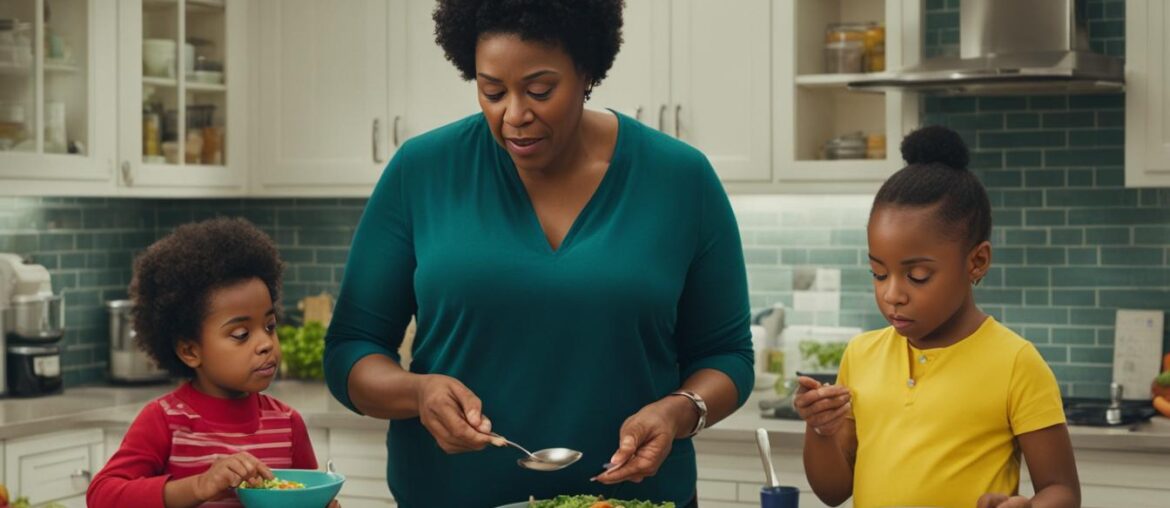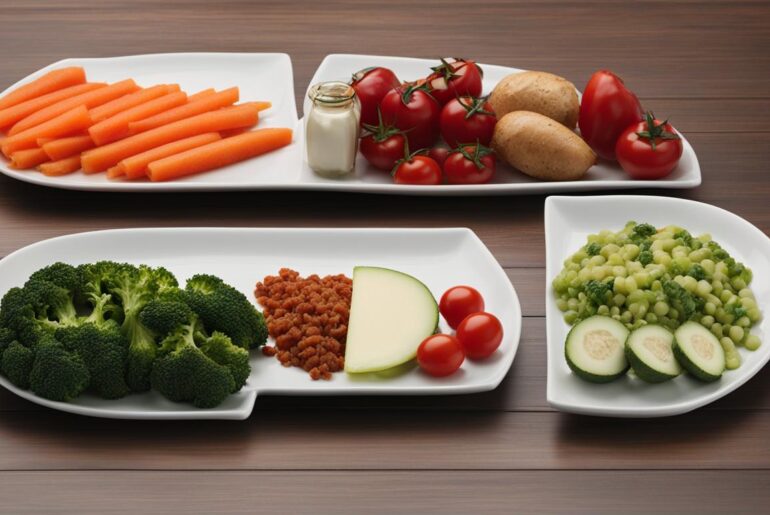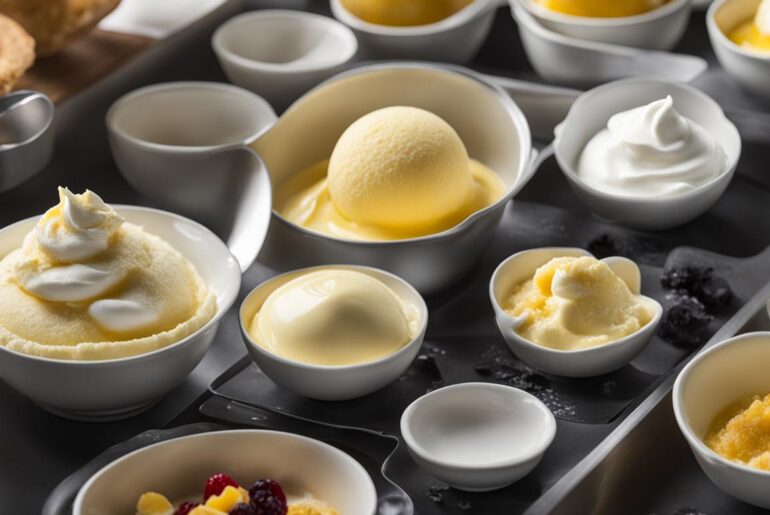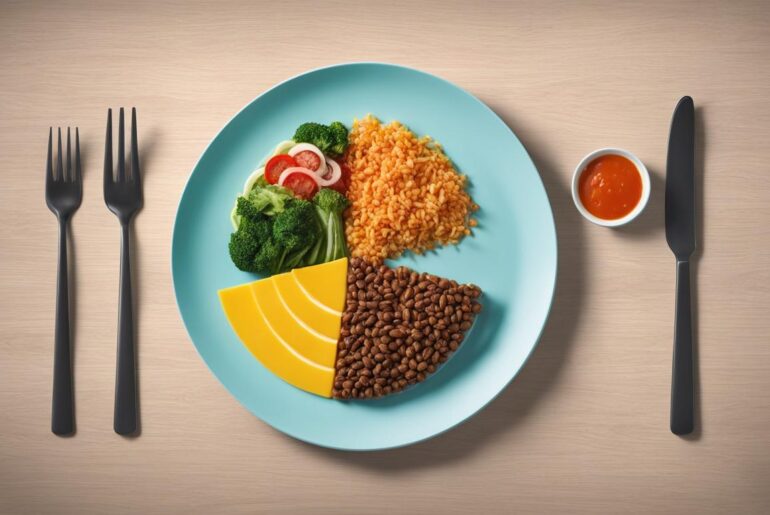Teaching kids portion control is crucial for their overall well-being and fostering healthy eating habits. By instilling these habits early on, we can prevent overeating, promote balanced nutrition, and set our children up for a lifetime of healthy choices. In this article, I will share my top strategies for teaching kids portion control.
Key Takeaways
- Teaching portion control to kids is essential for promoting healthy eating habits.
- By being a role model, explaining portion sizes, and involving children in meal preparation, we can help them understand the importance of balanced nutrition.
- Mindful eating and using portion control tools like divided plates can aid in teaching kids about appropriate serving sizes.
- Engaging activities, such as estimating portions using common objects, can make learning about portion control fun and interactive for children.
- Implementing portion control at home and when eating out can reinforce healthy habits and prevent overeating.
The Importance of Portion Control for Children’s Health
Portion control plays a vital role in promoting healthy eating habits for children and ensuring their overall well-being. With the increasing prevalence of childhood obesity, it is crucial to educate kids about proper portion sizes to prevent excessive weight gain and reduce the risk of chronic diseases. By implementing portion control education for children, we can empower them to make healthier food choices and improve their nutritional intake.
Teaching children about portion control not only helps them develop healthy eating habits but also instills a sense of moderation and balance when it comes to food. By understanding appropriate portion sizes, children can better regulate their calorie intake and avoid overeating, leading to weight management and a reduced risk of obesity-related health issues.
Additionally, promoting healthy eating in children through portion control education can have a long-lasting impact on their overall health and well-being. By teaching kids about portion sizes, we equip them with the knowledge and skills necessary to make informed decisions about their food choices. This education empowers children to be mindful of their eating habits and encourages them to consume a variety of nutritious foods from different food groups, ensuring a well-rounded and balanced diet.
“Teaching children portion control is a fundamental step in fostering a healthy relationship with food and promoting their overall health and well-being.”
By emphasizing portion control as part of a comprehensive approach to healthy eating, parents and caregivers can set the foundation for a lifetime of good nutrition. It is important to teach children the difference between portion sizes and serving sizes. Portion sizes refer to the amount of food that is consumed, while serving sizes are standardized measurements used for nutritional information. Teaching children to recognize proper portion sizes helps them develop an understanding of appropriate food quantities and supports them in making healthier food choices.
To promote portion control education for children, it is essential to provide practical examples and visual aids that help them better understand serving sizes. By using divided plates or containers, parents can visually demonstrate appropriate portion sizes for different food groups. This hands-on approach enables children to visualize and internalize appropriate food quantities, enhancing their ability to practice portion control.
By teaching children about portion control and promoting healthy eating habits, we can help them develop a positive relationship with food, make informed nutritional choices, and support their overall health and well-being.
Promoting Healthy Eating Habits through Portion Control
When children learn about portion control, it empowers them to make mindful decisions about the food they consume. Here are a few key benefits of promoting healthy eating habits through portion control:
- Balanced Nutrition: Teaching children about portion control helps them appreciate the importance of consuming a balanced diet that includes a variety of nutrients from different food groups.
- Decreased Overeating: Portion control education helps children recognize when they’ve had enough food, reducing the likelihood of overeating and the associated health risks.
- Weight Management: By understanding portion sizes and practicing portion control, children can better manage their weight and reduce the risk of childhood obesity.
- Prevention of Chronic Diseases: Developing healthy eating habits through portion control can help children reduce their risk of chronic diseases such as diabetes, heart disease, and certain types of cancer.
- Sense of Moderation: Teaching children portion control encourages them to adopt a balanced approach to eating and understand the importance of moderation in all aspects of life.
As parents and caregivers, it is our responsibility to prioritize our children’s health and well-being. By promoting healthy eating habits through portion control education, we can empower children to make informed choices about their nutrition, encourage lifelong habits, and set them up for a healthy future.
Strategies for Teaching Portion Control to Children
Teaching children about portion control is crucial for instilling healthy eating habits. Here are some effective strategies to help you teach your kids about portion sizes:
-
Be a role model:
Show your children the importance of portion control by demonstrating healthy eating habits yourself. Let them observe how you choose appropriate serving sizes and make balanced food choices.
-
Use visual aids:
Visual aids can help children understand portion sizes better. Show them images or diagrams that depict appropriate serving sizes for different types of food. You can also use divided plates or containers to visually demonstrate portion control.
-
Involve them in meal preparation:
Get your kids involved in preparing meals. This allows them to learn about different food groups and portion sizes firsthand. Encourage them to measure ingredients and understand how different foods contribute to a balanced diet.
-
Promote mindful eating:
Teach your children to listen to their body’s hunger and fullness cues. Encourage them to eat slowly, savor each bite, and pay attention to the signals their body sends when they are satisfied. This helps prevent overeating and promotes a healthier relationship with food.
-
Avoid food as a reward:
Avoid using food as a reward or punishment. This can create an unhealthy association with food and undermine portion control. Instead, find non-food rewards or praise your child for making healthy choices.
-
Discuss food labels:
For older children, introduce the concept of reading food labels and understanding the serving sizes and nutritional information. Teach them how to make informed choices based on the information provided.
Benefits of Teaching Portion Control to Children
This table highlights the benefits of teaching children about portion control:
| Benefits | Explanation |
|---|---|
| Prevents overeating | Teaching portion control helps children recognize appropriate serving sizes, reducing the likelihood of overeating. |
| Promotes balanced nutrition | Understanding portion sizes encourages children to include a variety of foods in their diet, ensuring they receive balanced nutrition. |
| Develops healthy eating habits | Learning portion control at a young age helps children develop lifelong healthy eating habits, supporting their overall well-being. |
By implementing these strategies and emphasizing the importance of portion control, you can empower your children to make mindful choices about their food intake and develop a healthy relationship with food.
Engaging Activities to Teach Portion Control
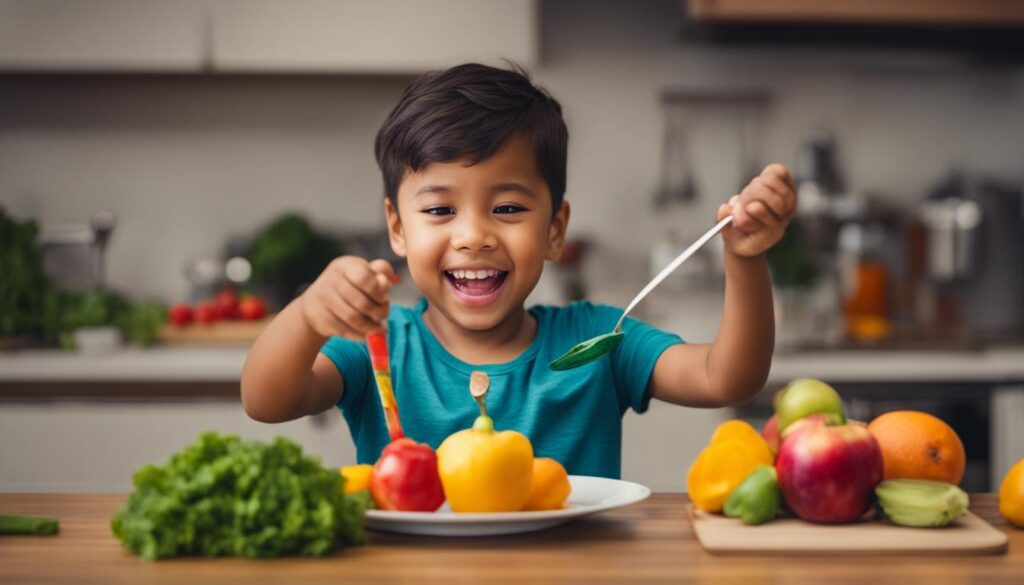
Engaging activities can make learning about portion control fun and interactive for kids. One activity you can try is estimating accurate portions using common objects or comparing portion sizes to everyday items like a deck of cards or a tennis ball. Another activity is exploring the ChooseMyPlate.gov Food Gallery to create your own comparison of portion size to common objects. These activities help children visualize and understand appropriate portion sizes in a relatable way.
One engaging activity to teach portion control to kids is estimating portion sizes using common objects. For example, you can ask your child to estimate the portion size of rice by comparing it to the size of a deck of cards. This activity not only helps them understand portion sizes but also enhances their visual perception skills. It’s a fun and interactive way to introduce the concept of portion control.
Comparing portion sizes to everyday objects
Another engaging activity is comparing portion sizes to everyday objects. You can show your child a tennis ball and explain that a serving of fruit should be about the same size. This helps them associate portion sizes with objects they encounter in their daily lives, making it easier for them to understand and remember. You can extend this activity by creating a visual chart or a poster with different common objects and their corresponding portion sizes.
Engaging activities like estimating portion sizes using common objects and comparing portion sizes to everyday items provide children with a hands-on learning experience. By making portion control relatable and interactive, these activities help children develop a better understanding of appropriate serving sizes and foster healthy eating habits.
| Activity | Description |
|---|---|
| Estimating portion sizes using common objects | Have your child estimate portion sizes using common objects like a deck of cards or a tennis ball. |
| Comparing portion sizes to everyday objects | Show your child everyday objects and explain how they relate to appropriate portion sizes. |
Practical Tips for Implementing Portion Control at Home
Implementing portion control at home is crucial for reinforcing healthy eating habits. By teaching kids about portion control, you can help them develop a balanced approach to food and prevent overeating. Here are some practical tips to incorporate portion control into your family’s daily routine:
1. Use Smaller Plates
One effective way to control portion sizes is to serve meals on smaller plates. Research shows that using smaller plates can help reduce the amount of food consumed without sacrificing satisfaction. By visually filling up the plate, your child will feel satisfied with a smaller portion.
2. Avoid Doubling Up on Carbohydrates
When preparing meals, try to avoid serving multiple carbohydrate-rich foods in the same meal. For example, if you’re serving pasta as the main dish, opt for a side of vegetables instead of bread or rice. This helps promote a more balanced and nutritious meal.
3. Incorporate Measuring Cups or Everyday Objects
Measuring cups or everyday objects like a tennis ball or deck of cards can be used as visual aids to help children understand appropriate portion sizes. For example, half a cup of cooked rice is roughly the size of a tennis ball. This simple method can make portion control more tangible and understandable for kids.
4. Encourage Selective Seconds
Teach your child the importance of listening to their body’s hunger and fullness cues. Encourage them to wait for a few minutes before deciding if they’re still hungry for seconds. This allows their body to register fullness and prevents mindless overeating.
5. Discourage Picking at Leftovers
Leftovers can be tempting, but encourage your child to make fresh, balanced meals instead of snacking on leftover portions. This will help them practice portion control and maintain a healthy eating pattern throughout the day.
6. Practice the 20-minute Rule
Teach your child to wait for at least 20 minutes before getting a second helping. It takes time for the body to realize it’s full, and waiting allows your child to assess if they’re truly hungry or if they’re just eating out of habit or boredom.
7. Teach Kids to Check Food Labels
Show your child how to read food labels and identify serving sizes. This empowers them to make informed choices about the quantities they consume. Encourage them to compare serving sizes to understand how much they should be eating.
Implementing portion control at home is a valuable skill that will benefit your child’s long-term health and well-being. By following these practical tips, you can create a supportive environment that encourages healthy eating habits and portion awareness.
Portion Control Tips When Eating Out
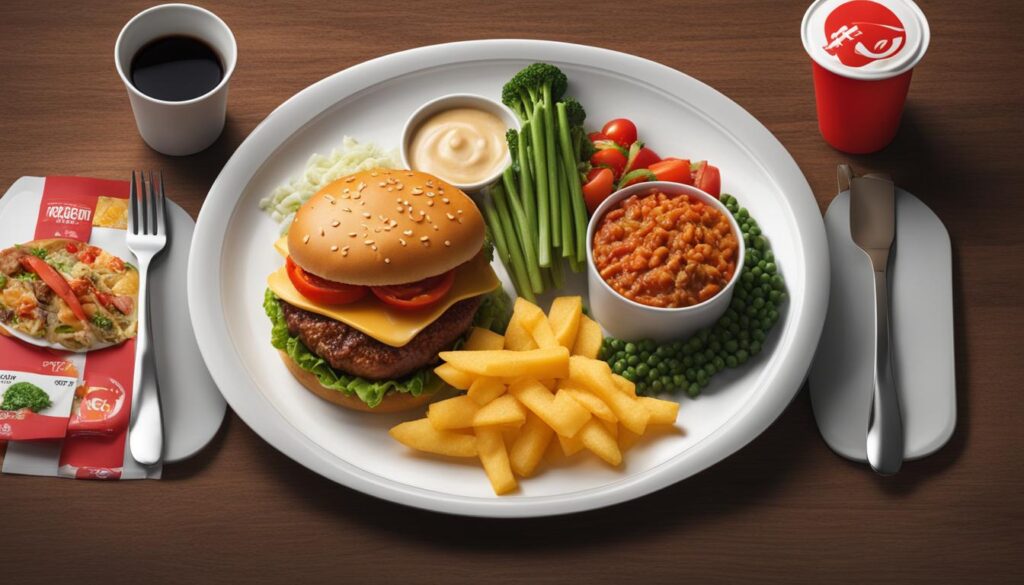
Eating out can pose challenges when it comes to maintaining portion control. However, with a few mindful strategies, you can still enjoy a delicious meal without overindulging. Here are some helpful tips for portion control when dining out:
-
Say no to the bread basket: It can be tempting to fill up on bread before your meal, but keep in mind that those extra carbs can add up. Opt to skip the bread or limit yourself to a single piece.
-
Choose healthier side options: Many restaurants offer alternative side dishes such as steamed vegetables or a side salad. Opt for these healthier choices instead of higher-calorie options like fries or mashed potatoes.
-
Be mindful of supersized portions: Restaurant portions are often larger than what you need. Consider sharing a meal with a friend or asking for a half portion. Alternatively, ask for a to-go box at the beginning of your meal and pack up the leftovers to enjoy later.
-
Listen to your body: Pay attention to your body’s hunger and fullness cues. Eat slowly and stop eating when you feel comfortably satisfied, even if there is food left on your plate.
To visually illustrate portion control when eating out, refer to the table below:
| Restaurant Dish | Portion Size |
|---|---|
| Chicken Caesar Salad | Approximately 1 cup |
| Pasta with Marinara Sauce | About 1 cup or the size of your fist |
| Grilled Chicken Breast | A deck of cards or palm-size |
| French Fries | A small handful or about 10 fries |
| Ice Cream Scoop | 1/2 cup or approximately the size of a tennis ball |
Quote:
“By being mindful of portion sizes when eating out, you can still enjoy your favorite meals without derailing your healthy eating habits.” – John Smith, Nutrition Expert
By following these portion control tips, you can make informed choices when dining out and maintain a balanced diet (see my post here). Remember to listen to your body, choose healthier options, and be mindful of portion sizes. Keeping these strategies in mind will help you stay on track with your health goals, even when enjoying a meal at a restaurant.
Conclusion
Teaching kids portion control is an essential aspect of fostering healthy eating habits. By implementing the strategies mentioned in this article, you can empower your children to make mindful choices about their food intake, prevent overeating, and maintain a balanced and nutritious diet.
To effectively teach portion control, it is crucial to lead by example. Be a role model and demonstrate healthy eating habits yourself. Involve your kids in meal preparation and engage in activities that make portion control fun and relatable. By doing so, you will not only teach them the importance of portion control but also instill a positive relationship with food.
With consistent effort and support, you can set your child up for a lifetime of healthy eating habits. Remember, teaching portion control is not just about restricting food but rather about fostering a healthy mindset towards nutrition. By teaching your children to listen to their bodies and make mindful choices, you are equipping them with valuable skills that will benefit them throughout their lives.

